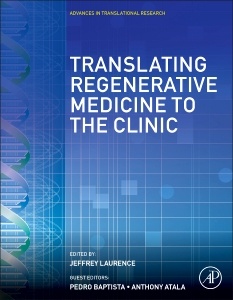Translating Regenerative Medicine to the Clinic
Coordonnateurs : Laurence Jeffrey, Baptista Pedro, Atala Anthony

Translating Regenerative Medicine to the Clinic reviews the current methodological tools and experimental approaches used by leading translational researchers, discussing the uses of regenerative medicine for different disease treatment areas, including cardiovascular disease, muscle regeneration, and regeneration of the bone and skin.
Pedagogically, the book concentrates on the latest knowledge, laboratory techniques, and experimental approaches used by translational research leaders in this field. It promotes cross-disciplinary communication between the sub-specialties of medicine, but remains unified in theme by emphasizing recent innovations, critical barriers to progress, the new tools that are being used to overcome them, and specific areas of research that require additional study to advance the field as a whole.
Volumes in the series include Translating Gene Therapy to the Clinic, Translating Regenerative Medicine to the Clinic, Translating MicroRNAs to the Clinic, Translating Biomarkers to the Clinic, and Translating Epigenetics to the Clinic.
PART I: STEM CELLS:
Chapter 1: Introduction and Overview of Stem Cells
Chapter 2: Mechanistic Insights from Pathologic Perspective
Chapter 3: Large Animal Models to Study Stem Cell Therapy
Section I. Body’s Native Repair Mechanisms
Chapter 4. Evolution of understanding of the mechanisms of repair
Chapter 5: Impact of Age on Stem Cell Function
Section II: Autologous Bone Marrow
Chapter 6: Bone Marrow Mononuclear Cells
Chapter 7: Chronic Limb Ischemia
Chapter 8: Chronic/Refractory Angina
Chapter 9: Acute Myocardial Infarction
A. European Experience: Andreas Zeiher
B. US Experience: Jay Traverse
Chapter 10: Chronic Ischemic Heart Failure
Section III: Autologous Adipose Derived Regenerative Cells
Chapter 11: Adipose Tissue
Section IV: Allogeneic Alternatives to Autologous Bone Marrow
Chapter 12: Overview of MSCs
Chapter 13: Allogeneic vs Autologous Source: Comparative Effects
Chapter 14: Use of MSCs for AMI
Chapter 15: Combined Cell Strategies
Chapter 16: Heart Failure
Section V: Cardiac Progenitor Cells
Chapter 17: C-Kit+ cells
Chapter 18: Cardiospheres
Section VI: Other Allogeneic Sources of Stem Cells
Chapter 19: Umbilical Cord, Placenta, Endometrium
Section VII. Genetic Engineering/Cell Transformation
Chapter 20: Genetic Engineering of Fibroblasts to Cardiomyocytes
Chapter 21: Transformation to inducible Pleuripotent Stem Cells
Chapter 22: Transformation to MAPC's
Section VIII: METHODS OF DELIVERY:
Chapter 23. Transcoronary and Endocardial
Chapter 24. Retrograde and Epicardial
Part II. TISSUE ENGINEERING:
Chapter 25. Epicardial Patch
Chapter 26. Matrix Scaffolds
Chapter 27. Matrix plus cells
Chapter 28. Biomaterial
Chapter 29: Organogenesis
Part III. GENE THERAPY:
Chapter 30: Pre-clinical Identification of target genes
Chapter 31: SERCA-2a gene for recovery of inotropic function
Chapter 32: SDF-1 Gene for Heart Failure Non-Inotropic Mechanisms
Chapter 33: Gene Therapy for Angiogenesis: Chronic Limb Ischemia
Chapter 34: Stem Cells Target Gene Transfected Stem Cells
Part IV: FUTURE DIRECTIONS:
Chapter 35: CCTRN: Past, Present, and Vision for the Future
Chapter 36: Signature of Responders-lessons from Bio-Repository
Chapter 37: Adjunctive therapy with LVADs for Recovery
Chapter 38: Trials in Non-Ischemic Heart Failure
Chapter 39: Enhancing Stem Cell Homing for Tissue Repair
Chapter 40: Stroke: Pre-Clinical and Clinical Trial Data
SUMMARY
Dr. Pedro Baptista is originally from Portugal, where he graduated from the School of Pharmacy of the University of Lisbon. He completed his doctoral dissertation at the Gulbenkian Ph.D. Program in Biomedicine. He is currently a Group Leader at the Health Research Institute of Aragon in Zaragoza, Spain and the founder of the Organ Bioengineering and Regenerative Medicine Laboratory at this institution. He is also an Assistant Professor at the Department of Biomedical and Aerospace Engineering at University Carlos III of Madrid, Spain. He is one of the founders and the Deputy Chairman of the European Association for the Study of the Liver Consortium for Regenerative Hepatology and currently the Deputy Secretary General and an elected Board Governor of the European Society for Artificial Organs. His current research focuses on creating bioengineered livers that can finally make the long-term transplantation of these lab-grown organs a reality.Dr. Pedro Baptista is originally from Portugal, where he graduated from the School of Pharmacy of the University of Lisbon. He completed his doctoral dissertation at the Gulbenkian Ph.D. Program in Biomedicine. He is currently a Group Leader at the Health Research Institute of Aragon in Zaragoza, Spain and the founder of the Organ Bioengineering and Regenerative Medicine Laboratory at this institution. He is also an Assistant Professor at the Department of Biomedical and Aerospace Engineering at University Carlos III of Madrid, Spain. He is one of the founders and the Deputy Chairman of the European Association for the Study of the Liver Consortium for Regenerative Hepatology and currently the Deputy Secretary General and an elected Board Governor of the European Society for Ar
- Encompasses the latest innovations and tools being used to develop regenerative medicine in the lab and clinic
- Covers the latest knowledge, laboratory techniques, and experimental approaches used by translational research leaders in this field
- Contains extensive pedagogical updates aiming to improve the education of translational researchers in this field
- Provides a transdisciplinary approach that supports cross-fertilization between different sub-specialties of medicine
Date de parution : 12-2015
Ouvrage de 354 p.
21.4x27.6 cm



